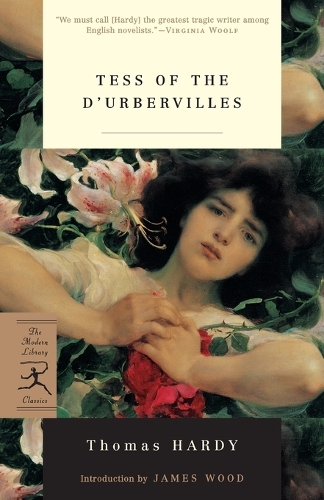
Tess of the d'Urbervilles: A Pure Woman
(Paperback)
Available Formats
Paperback
Published: 22nd April 1998
Paperback
Published: 3rd November 2008
Hardback
Published: 2nd December 1991
Paperback
Published: 15th March 2015
Paperback, Main
Published: 24th April 2018
Paperback
Published: 1st September 2013
Hardback
Published: 3rd September 2009
Hardback
Published: 8th May 2018
Paperback
Published: 5th September 2006
Paperback
Published: 21st November 2012
Hardback, New edition
Published: 15th February 2020
Paperback
Published: 5th May 1992
Paperback
Published: 26th May 2005
Paperback
Published: 15th March 2001
Publishing Details
Tess of the d'Urbervilles: A Pure Woman
By (Author) Thomas Hardy
Introduction by James Wood
Random House USA Inc
Modern Library Inc
15th March 2001
United States
Classifications
General
Fiction
823.8
Runner-up for The BBC Big Read Top 100 2003
Physical Properties
Paperback
544
Width 132mm, Height 203mm, Spine 28mm
448g
Description
Hardy's classic tale of a young heroine hurtling toward a tragic and ill fated end.
Author Bio
Thomas Hardy was born on June 2, 1840, in a thatched-roof cottage in upper Bockhampton, Dorset, England, a prophetic birthplace that lay in the center of 'Wessex,' the fictional region of southwest England which would serve as the backdrop for his novels. The eldest son of a prosperous builder and stonemason, Hardy was educated at the village school and apprenticed at the age of sixteen to local architect and church restorer John Hicks. In 1862 he went to London to pursue his architectural career; he also began writing at this time. Hardy returned to Dorset in 1867 to become assistant to John Hicks and wrote his first novel, The Poor Man and the Lady, of which only fragments remain. Although George Meredith, who was reader for Chapman & Hall publishers, advised against its publication, he encouraged Hardy to keep writing, preferably a story with a more complicated plot. Over the next several years he produced three more novels- Desperate Remedies (1871) and Under the Greenwood Tree (1872) were published anonymously, but A Pair of Blue Eyes (1873) bore the author's name. In November 1872, Leslie Stephen, the distinguished critic and editor, wrote to Hardy inviting him to contribute a novel for serialization in the Cornhill Magazine, a prestigious monthly that had published the work of such established writers as Anthony Trollope. Hardy accepted and in his letter to Stephen added that 'the chief characters would probably be a young woman-farmer, a shepherd, and a sergeant of cavalry.' He wrote Far from the Madding Crowd both in and out of doors at Bockhamptom as if possessed. 'Occasionally without a scrap of paper at the very moment when I felt volumes . . . I would use large dead leaves, white chips left by the woodcutters, or pieces of stone or slate that came to hand,' Hardy later recalled. Published anonymously in 1874, Far from the Madding Crowd sold out in just over two months and marked the turning point in Hardy's literary career. As Virginia Woolf later noted- 'The subject was right; the method was right; the poet and the countryman, the sensual man, the sombre reflective man, the man of learning, all enlisted to produce a book which, however fashions may chop and change, must hold its place among the great English novels.' The success of Far from the Madding Crowd in 1874 encouraged Hardy to abandon architecture and devote himself entirely to the craft of fiction. His next novel, The Hand of Ethelberta (1876), also appeared in the Cornhill Magazine but did not repeat the success of its predecessor. In 1874 Hardy married Emma Lavinia Gifford, and the couple soon settled in an idyllic cottage overlooking the Dorset Stour, at Sturminster Newton, where Hardy wrote The Return of the Native (1878). In 1878 he moved to London. Although he became a well-known figure in literary circles and was considered a catch for hostesses, Hardy wrote three disappointing 'minor' novels during his years there- The Trumpet-Major (1880), A Laodicean (1881), and Two on a Tower (1882). This fallow period in his career seemed to lift in 1885 with his return to Dorset to live at Max Gate. Over the next three years he published The Mayor of Casterbridge (1886), which many regard as his greatest tragic novel, The Woodlanders (1887), and his first collection of short stories, Wessex Tales (1888). In 1891 Tess of the d'Urbervilles appeared, and in 1895 Hardy's final novel, Jude the Obscure, came out. The book sent shock waves of indignation rolling across Victorian England. It was denounced as pornography and subjected the author to an avalanche of abuse. Hardy's disgust at the public's reaction led him to announce in 1896 that he would never again write fiction. During the remaining years of his life, Hardy devoted himself to poetry, publishing his first book of verse, Wessex Poems, in 1898
